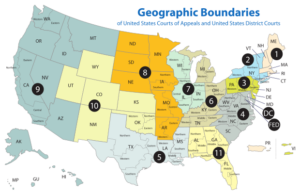The United States federal court system is a hierarchical structure consisting of three levels: the district courts, the courts of appeals, and the Supreme Court. District courts are trial-level courts who have jurisdiction over a wide range of federal cases, including criminal cases, civil cases involving federal law, and cases involving federal agencies. The courts of appeals are intermediate appellate courts, who hear appeals from the district courts and other federal agencies within their geographic jurisdiction. The Supreme Court is the highest court in the United States, and has the final say on all cases involving federal law and the United States Constitution.
 The federal court system was established by the Constitution, which gives Congress the power to create and regulate federal courts. Our first federal courts were created by the Judiciary Act of 1789, which only established district courts and the Supreme Court. The Act also created the Office of the Attorney General and provided for the appointment of federal judges by the President, with the advice and consent of the Senate.
The federal court system was established by the Constitution, which gives Congress the power to create and regulate federal courts. Our first federal courts were created by the Judiciary Act of 1789, which only established district courts and the Supreme Court. The Act also created the Office of the Attorney General and provided for the appointment of federal judges by the President, with the advice and consent of the Senate.
Over time, the federal court system has evolved and expanded to meet our country’s changing needs. The number of federal district courts and judges has increased while new courts of appeals have been established.
The United States Court of Appeals for the Third Circuit (in case citations, 3d Cir.) is a federal court with appellate jurisdiction over the district courts for the following districts:
- District of Delaware
- District of New Jersey
- Eastern District of Pennsylvania
- Middle District of Pennsylvania
- Western District of Pennsylvania
Landmark Third Circuit rulings include:
- United States v. Enmons (1973) – establishing that union officials cannot be charged with extortion for demanding wages and benefits for their members.
- Betts v. Brady (1942) – holding that the Sixth Amendment’s guarantee of counsel did not apply in state courts.
- Merck & Co., Inc. v. Reynolds (2010) – holding that federal law preempts state law in drug labeling cases, protecting drug manufacturers from state lawsuits.
- United States v. Ursery (1996) – holding that the government could use civil asset forfeiture to seize property used in illegal drug operations.
- United States v. Kordel (1944) – holding that the government may regulate speech that is “intended or likely to provoke a violent reaction.”
These cases illustrate the wide range of legal issues and controversies that the Third Circuit has considered, and their decisions have had a lasting impact on U.S. law.